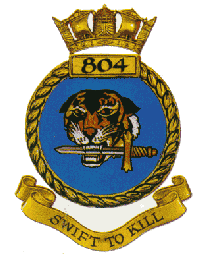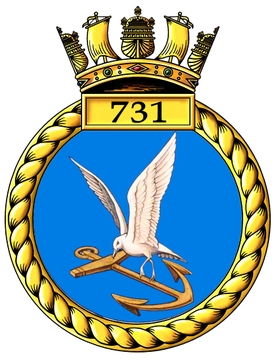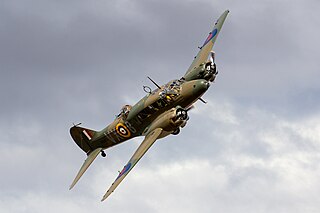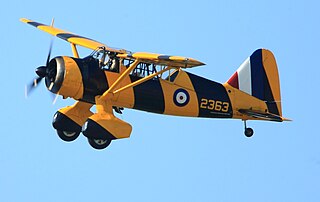714 Naval Air Squadron was a squadron of the Royal Navy's Fleet Air Arm. It was first formed as 714 (Catapult) Flight on 15 July 1936, by renumbering 406 (Catapult) Flight, and operated Fairey IIIF floatplanes from cruisers in the East Indies. The Fairey IIFs were quickly replaced by Hawker Osprey floatplanes and Supermarine Walrus flying boats, and in 1937 these were supplemented by Fairey Seafox floatplanes. By July 1938 it had consolidated on the Walrus as equipment, and in early 1939 it was upgraded to full squadron status. It was disbanded on 21 January 1940, when all the Fleet Air Arm's catapult units were merged to form 700 Naval Air Squadron.
Royal Air Force Heathfield, or more commonly RAF Heathfield, sometimes known as RAF Ayr/Heathfield due to its proximity to Glasgow Prestwick Airport, which was also used by military flights, is a former Royal Air Force station. It opened in April 1941 as an airbase for day and night fighter squadrons. In September 1944 it transferred to Fleet Air Arm control and commissioned as HMS Wagtail. The Royal Navy paid off the airbase in March 1946 and it was reduced to care and maintenance. The United States Air Force used it for storage between 1951 and 1957, with the designation USAAF Station 570.

804 Naval Air Squadron was a Naval Air Squadron of the Royal Navy, formed in November 1939 from part of 769 NAS Sea Gladiators which had been detached to RNAS Hatston. The squadron was merged into 800 NAS in June 1944 and subsequently reformed in September.

Royal Naval Air Station Burscough, was a Fleet Air Arm (FAA) naval air station which was 1.5 miles (2.4 km) southwest of Burscough, Lancashire. The Admiralty acquired 650 acres (2.6 km2) of land in December 1942 and the airfield was built with four narrow runways and several hangars, being commissioned on 1 September 1943.

819 Naval Air Squadron was a Naval Air Squadron of the Royal Navy's Fleet Air Arm.
882 Naval Air Squadron was a Naval Air Squadron of the Royal Navy's Fleet Air Arm. It was formed as a carrier based fighter squadron in July 1941 and served through the rest of the Second World War. It took part in the British invasion of Madagascar and Operation Torch, the Anglo-American invasion of North Africa in 1942, and in the invasion of Southern France in August 1945, also taking part in operations in the Aegean and off Norway. It was disbanded after the end of the war, in October 1945.

707 Naval Air Squadron was a Naval Air Squadron of the Royal Navy's Fleet Air Arm which disbanded during February 1995. It was active during the Second World War forming during February 1945 as a Radar Trials Unit, disbanding in October of the same year. It reformed December 1964, as an Advanced and Operational Flying Training Commando helicopter squadron.

709 Naval Air Squadron was a Naval Air Squadron of the Royal Navy's Fleet Air Arm which last disbanded during January 1946. It formed in September 1944 within the School of Naval Air Warfare as the Ground Attack School using both the British Supermarine Seafire and the American Grumman Hellcat fighter aircraft for training. The squadron spent its whole sixteen month existence based at HMS Vulture, Royal Naval Air Station St. Merryn.

722 Naval Air Squadron was a Naval Air Squadron of the Royal Navy's Fleet Air Arm (FAA) created on 7th September 1944, as a Fleet Requirements Unit, where it was responsible for assisting in ship and aircraft gunnery practice. On 24 October 1945 the squadron disbanded following the end of the Second World War.

731 Naval Air Squadron was a Naval Air Squadron of the Royal Navy's Fleet Air Arm (FAA). It was active between 1943 and 1945 and its sole role throughout its formation was a Deck Landing Control Officer training squadron. Through this role the squadron pilots were nicknamed 'Clockwork Mice'. It was based out of the purpose built airbase, commissioned as HMS Peewit, known as Royal Naval Air Station East Haven, in Scotland, as part of the Deck Landing Training School there.

741 Naval Air Squadron was a Naval Air Squadron of the Royal Navy's Fleet Air Arm which last disbanded during November 1947. It was initially active, between March 1943 and March 1945 as an Observer Training Squadron at HMS Condor, RNAS Arbroath, Scotland, as part of the No. 2 Observer Training School. It reformed at HMS Vulture, RNAS St. Merryn, England, as an Operational Flying Training Unit in August 1946.

745 Naval Air Squadron was a Naval Air Squadron of the Royal Navy's Fleet Air Arm. It was initially active from 1943 to 1945 as a Telegraphist Air Gunner Training squadron, part of No.2 Telegraphist Air Gunner School based at R.N. Air Section Yarmouth, Nova Scotia, Canada. It reformed in April 1956 at HMS Gannet, RNAS Eglinton, Northern Ireland, as a Radar Jamming Trials Unit. It operated with four modified Grumman Avenger aircraft, undertaking a trials evaluation of the 'Orange Harvest' radar warning receiver equipment, disbanding in November 1957.

747 Naval Air Squadron was a Naval Air Squadron of the Royal Navy's Fleet Air Arm which last disbanded in December 1945. 747 Naval Air Squadron was part of the Torpedo Bomber Reconnaissance Pool and formed at HMS Owl, RNAS Fearn, in March 1943, evolving into an Operational Training Unit. July saw the squadron move to HMS Nightjar, RNAS Inskip and became part of No. 1 Naval Operational Training Unit. It returned to HMS Owl in January 1944 and then to HMS Urley, RNAS Ronaldsway, in July. In November 1945 the squadron headquarters moved to HMS Jackdaw, RNAS Crail, leaving a Flight at HMS Urley.

752 Naval Air Squadron was a Naval Air Squadron of the Royal Navy's Fleet Air Arm. Formed in May 1939, at RNAS Ford as an Observer Training Squadron, it was active through to 1945 as part of No. 1 Observer School. Ford was attacked in August 1940 and the squadron moved to RNAS Lee-on-Solent for a one month stay. From November 1940, through to disbandment in October 1945, it operated at RNAS Piarco , Trinidad.

754 Naval Air Squadron was a Naval Air Squadron of the Royal Navy's Fleet Air Arm. It was active as an Observer Training Squadron from 1939 to 1944 as part of No. 2 Observer School, forming out of the School of Naval Co-operation RAF, in May 1939. It initially operated out of HMS Daedalus, RNAS Lee-on-Solent, Hampshire, however, after the Naval Air Station was attacked and bombed, it then moved to north to HMS Condor, RNAS Arbroath, Angus, Scotland, in September 1940. Here, it provided training for Observers and also Air Gunners and where four years later, in March 1944, it disbanded. The squadron then briefly reformed as a Air Gunner Training Squadron, as part of No. 1 Naval Air Gunners School, when 744 Naval Air Squadron was re-designated 754 Naval Air Squadron, in June 1944, at RN Air Section Yarmouth, Nova Scotia, Canada, until disbanding again, in March 1945.

793 Naval Air Squadron was a Naval Air Squadron of the Royal Navy's Fleet Air Arm which disbanded during October 1945. It was formed in October 1939 at RNAS Ford, as an Air Towed Target Unit, as part of No.1 Observer School. From 1940 to disbandment it operated at RNAS Piarco , Trinidad.
1771 Naval Air Squadron was a Naval Air Squadron of the Royal Navy's Fleet Air Arm. The squadron was the first British & Commonwealth unit to fly over Japan in World War II.
1830 Naval Air Squadron was a Naval Air Squadron of the Royal Navy's Fleet Air Arm.
1843 Naval Air Squadron was a Naval Air Squadron of the Royal Navy's Fleet Air Arm.












